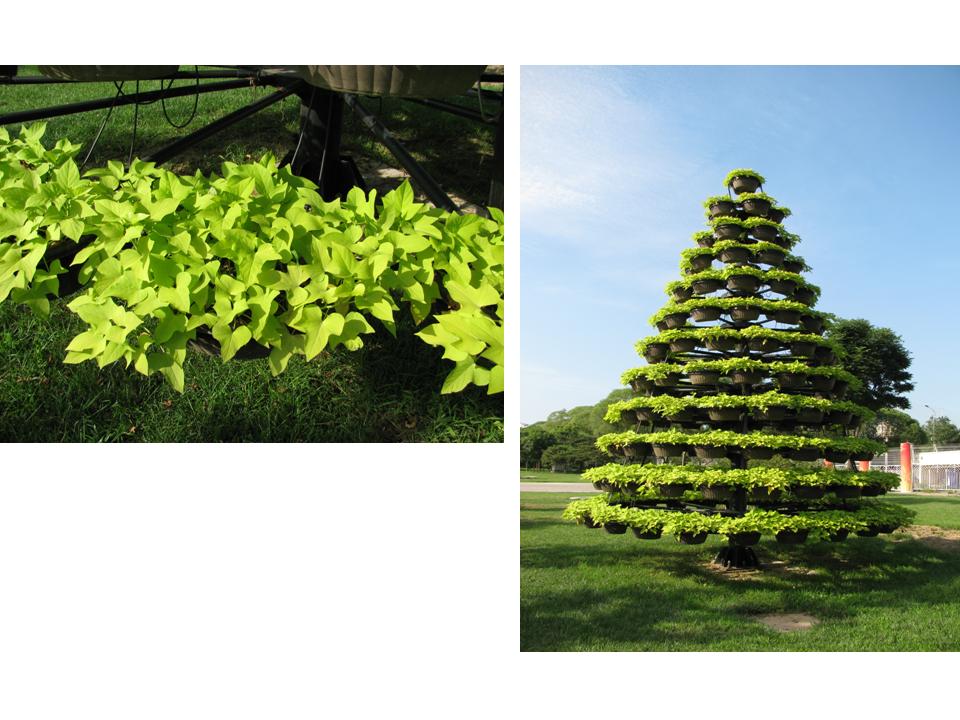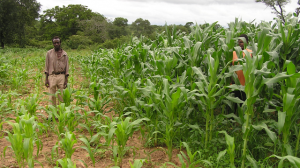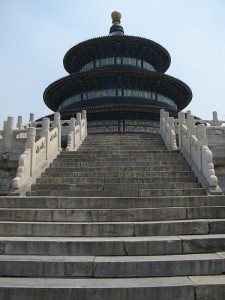Maybe someone out there can help me out with this. I was walking along a main thoroughfare towards the Bird’s Nest Stadium in Beijing and came across on the grass verge a construction consisting of tubs of what I believe may be sweet potato plants craftily arranged on a metal framework in the general shape of a Christmas tree. Here it is below (click on it to enlarge). Can somebody explain the point? Is this vegetative cone merely decorative, or do the plants have symbolic value? Are they in fact sweet potatoes?
Can somebody explain the point? Is this vegetative cone merely decorative, or do the plants have symbolic value? Are they in fact sweet potatoes?
Detoxifying cassava
Strategies that minimize one risk…may augment another risk… Peasant farmers are perfectly conversant with such linkages. The neglect of peasant agriculture by both donors and governments is among the deeper causes of current crises, along with the increasing inequality that deprives them of secure tenure to land and other resources, reducing benefits they can expect to receive from stewardship of these resources.
That comes towards the end of a lengthy, information-dense and closely argued paper on cassava’s domestication, evolution and chemical ecology by Doyle MacKey and others. 1 Coincidentally — or perhaps not — McKey also has a paper out just now on the evolutionary ecology of vegetatively propagated crops in general. 2 But that’s something for a future post, perhaps. Back to cassava.
Well, as I say, there’s a lot of stuff in the paper, but let me focus on a just a couple of things here. Some cassava varieties are high in poisonous cyanogens, requiring laborious and time-consuming processing for detoxification, which is almost exclusively done by women and, according to at least one anthropologist, serves to control them, “by limiting their freedom of action, in male-dominated societies.” So let’s replace those high-cyanogen, “bitter” varieties with low-cyanogen, “sweet” varieties, right?
Well, not so fast. ‘‘Interestingly enough, the women that are the custodians of this crop do not perceive the processing or the toxin to be a problem.’’ Bitter manioc is in fact better for food security for at least three reasons: it is protected against pests; immediate processing deters thieving; and the value added through processing reduces the social obligation to share. Overall, therefore, “processing bitter manioc is viewed as a useful and valorizing activity.”
But there are regular epidemics still in some parts of Africa of the paralytic disease konzo, which is “associated with several weeks of almost exclusive consumption of insufficiently processed bitter cassava.” Surely low-cyanogen varieties would be welcome there?
Again, the authors are dubious. They point out that agronomic practices, in particular careful nutrient management, together with adequate processing and a reasonably protein-rich diet are perfectly sufficient to manage the toxicity problem, and in fact normally do so. It is mainly when socioeconomic stability breaks down that konzo erupts. As they trenchantly put it: “This crop needs peace.” And reasonable rainfall. Drought stress tends to increase cyanogen levels. Plus, “[a]s they face food shortage, people may then take short cuts in processing bitter manioc.” In both cases, new, faster, more efficient detoxification methods will have a bigger impact than sweet varieties, with their greater susceptibility to pests.
In general, cassava is expected to be comparatively little affected by climate change, and is being promoted in some quarters as a “food for the future.” Fair enough, say the authors, but this
…will need to be accompanied by the necessary education for processing, as planting less bitter cultivars appears not to be a solution. Farmers have good reasons for preferring bitter varieties.
Indeed they do. So let me end with another heady quote, again from the concluding section of the paper, a little further on from the quote I started with.
We must have the humility and the broad vision to accept that our science can provide essential pieces, but only pieces, of viable solutions. ‘‘Modern’’ science can work in creative ways with folk knowledge. But no technological fix is a ‘‘magic bullet’’.
Livestock reverse desertification
There’s something delicious about received wisdom being overturned. For example, you’ll hear it said, categorically, that livestock turn fragile landscapes into desert; they eat the plants binding the soil, and their hooves cut up the surface and promote erosion. But it ain’t necessarily so.
Operation Hope, a Zimbabwean NGO and winners of $100,000 Grand Prize in the Buckminster Fuller Challenge, has
[T]ransformed 6,500 acres of of parched and degraded grasslands in Zimbabwe into lush pastures replete with ponds and flowing streams – even during periods of drought.
The quote is from a write-up in Seed magazine, which gives lots of details of the story. In essence, the key to livestock and grasslands is time, not numbers. If animals are on the land too long, their hooves do indeed powder the soil and they do overgraze. But if they are free to move on, or are moved by herders, moderate trampling allows rain to percolate into the soil, rather than run off and cause erosion. It also improves contact between seeds and soil, promoting germination. And dung and urine return plant matter to the soil to increase fertility and sequester more carbon, without becoming pollutants.
Operation Hope grazes animals in one spot for a maximum of three days, and they do not return for at least nine months, mimicking the natural movements of large herbivores on the savannah. At night they are protected from predators in portable kraals, which are also mobile to prevent a build-up of dung and urine. The effects are impressive. (“Animal-treated” field on the right, conventionally managed field on the left. Image courtesy Buckminster Fuller Institute”)

What’s interesting, and this is explored in much more detail in the Seed article, is that this kind of ecosystem thinking, which requires human knowledge and ingenuity to tackle complex problems, could have applications well beyond range management. Allan Savory, the scientist behind Operation Hope and the Africa Centre for Holistic Management, is hard on the Green Revolution.
“We posit the necessity of a new ‘Brown Revolution’, based on the regeneration of covered, organically rich, biologically thriving soil, and brought to fruition via millions of human beings returning to the land and the production of food.”
Of course, that’s hard work. But it is also surely much more interesting and fulfilling.
Another Hall of Prayer for Good Harvests
So you could say that the National Genebank of China which I talked about in the previous post is a sort of modern equivalent of this building, the Hall of Prayer for Good Harvests in Bejing‘s Temple of Heaven complex. No word on whether there are landrace seeds embedded within it somewhere, as in that statue in Ulaanbaatar.

Nibbles: Ecosystems, Coops, Cacao, Agroforestry
- Focus on ecosystem conservation: grasslands in South Africa, mangroves around the world.
- FAO says cooperatives are good for you.
- Great set of cacao photos from Sustainable Harvest International.
- Video Q&A on agroforestry with Dr Dennis Garrity, Director General of ICRAF.